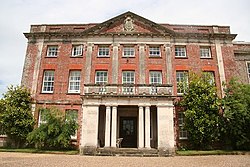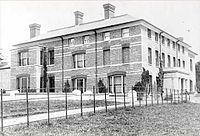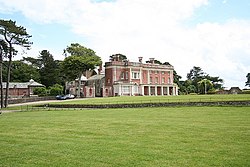Tapeley Park
| Tapeley Park | |
| Devon | |
|---|---|
 Tapeley Park | |
| Location | |
| Grid reference: | SS47782909 |
| Location: | 51°2’27"N, 4°10’22"W |
| History | |
| Country house | |
| Information | |
| Owned by: | Hector Christie |
| Website: | Christie Estates |
Tapeley Park is a country house in the parish of Westleigh in north Devon, which presides over the Tapeley Estate.
The present mansion house is a Grade II* listed building.[1] It was built or enlarged from an existing structure in about 1704, remodeled in the 19th century and again in the early 20th century when pilasters, portico, pediment and parapet were added to create a Queen Anne style building. In the mid 19th century the estate was inherited from the Clevland family by William Langham Christie of Glyndebourne in Sussex (whose grandson founded the Glyndebourne Opera Festival). A later heir, Hector Christie, briefly turned the house into a hippie commune.
In 2011 Tapeley Park was the subject of an episode of the Channel 4 television programme Country House Rescue, presented by the hotelier Ruth Watson, who advised on restoring the estate to a sound financial position.

The gardens are Grade II* listed in the National Register of Historic Parks and Gardens.[2] They are open to the public on a regular basis and feature Italianate terraces, a working kitchen garden and a permaculture garden. The estate, now mainly owned by the Christie Devon Estates Trust (trustees of the Christie family), comprises about 6,000 acres, and covers Saunton (including foreshore and beach), Braunton Burrows (sand dunes, partly a nature reserve and leased to the Ministry of Defence), Instow (including the foreshore purchased from the crown estate) and the village of Westleigh.[3]
History
William Pole the antiquary in the early seventeenth century reported that Tapeley has been held by the de Tapelegh family from the late thirteenth century. It later passed by marriage into the Grant family.[4] By the reign of Queen Elizabeth I the state had descended through several families to come into the Giffard family, with whom it remained until sold in 1702 to Commander William Clevland of the Royal Navy.[5]
In 1702, Commander Clevland, a Lanarkshire man by birth, sailed into port of Bideford, then one of the leading tobacco importation ports of Great Britain, he is said to have viewed from his ship the ancient mansion of Tapeley, in the parish of Westleigh, situated on an eminence overlooking the estuary of the River Torridge, and to have been so impressed by the beauty of its position that in 1704 he purchased the estate from the Giffard family.[6] He made Tapeley his residence.[7]
Colonel Augustus Saltren-Willett (1781–1849) assumed in 1847 by royal licence the surname and arms of Clevland in lieu of Willett[8] on inheritingthe estate from his great-uncle John Cleveland. The last of the family was Archibald Clevland, who died aged 21 at the Battle of Inkerman, having just one month before been one of the few officers who survived the Charge of the Light Brigade.
In the early 19th century, Agnes Clevland and her husband William Langham Christie rebuilt Tapeley Park with a "severe Victorian brick facade".[9]


Augustus Langham Christie (1857–1930) and his wife Lady Rosamond Wallop remodelled the house; Lady Rosmond in particular was responsible for the re-modelling of the house and for the landscaped gardens.[10] She first saw the house in the winter of 1881 before her marriage and in her journal she described the house as it then was as "A Georgian stucco house, very plain and rather dreary in appearance, for many of the front windows had been blocked...the terrace walk and garden did not exist and the drive approached between iron railings".[11] She moved to Tapeley in about 1886, four years after her marriage, and employed the architect John Belcher (1841–1913) to remodel the house in Queen Anne style, which work was carried out over time as finances allowed, before during and after the First World War. She affixed a plaque to a wall of the house in his memory.[12] She had effectively separated from her husband, who had become "eccentric",[13] and who moved to the nearby family mansion of Saunton Court, later remodelled in the 1930s by Edwin Lutyens. As an act of revenge against his wife he attempted to bequeath his estates to a distant cousin in Canada, thus cutting out their son John. She overturned his will in the courts on the grounds that he had been of unsound mind at the time of its making.
During the Second World War, Tapeley was used as a home for children evacuated from Plymouth. It later served as a home for the Invalid Children's Aid Association, then as a hotel. John's eldest son and heir to Glyndebourne was Sir George Christie (born 1934) but he bequeathed Tapeley to his daughter Rosamund Christie, who in turn left it to her nephew Hector Christie (born 1963). He was called by the Daily Mail newspaper "Britain's poshest protester...such a rebel he even rebels against the rebels...you name it – globalisation, war in Iraq, supermarkets – he's protested against it".[14] Shortly after his father's death in 2014 he and the estate's long-serving agent Raymond Coldwell parted company and he remarked:
Raymond has given me the freedom to do what I wanted to do. I've not made it very easy for him, looking after the estate which was what I should have been doing. But the one thing that's constant in life is change. Now I'm going to be turning my attention to the estate, making it more open and accessible. We've got a lot of work to do on the property and we're going to have to borrow a lot of money. I'm going to play a more active role".[15]
Pictures
 |
 |
Outside links
| ("Wikimedia Commons" has material about Tapeley Park) |
- Christie Estates – Tapeley Park
- Tapeley Park and Gardens
- Tapeley Park and Gardens: The Sustainable Stately Home in the Making
References
- ↑ Tapeley Park House - British Listed Buildings
- ↑ National Heritage List 1000692: Tapely Park
- ↑ Lauder, p.45
- ↑ Pole, p.391
- ↑ (National Archives: C 66/3525). Patent revoked 24 May 1732 (National Archives: C 66/3586). Per Collinge, J.M., Office-Holders in Modern Britain: Volume 7: Navy Board Officials 1660–1832, published 1978 [1]
- ↑ Risdon, Tristram: 'Survey of Devon'
- ↑ Lauder, Rosemary, Devon Families, Tiverton, 2002, p.41
- ↑ Burke, p.408; Lauder, p.42; Vivian, p.180
- ↑ Lauder, p.43
- ↑ Lauder, p.44
- ↑ Lauder, p.43
- ↑ Lauder, p.43
- ↑ Lauder, p.44
- ↑ Daily Mail on-line 25 May 2012
- ↑ North Devon Journal, 10 June 2014
- Lauder, Rosemary, Devon Families, Tiverton, 2002, pp. 41–5, Christie of Tapeley Park
- Burke's Genealogical and Heraldic History of the Landed Gentry, 15th Edition, ed. Pirie-Gordon, H., London, 1937, p. 408, pedigree of Clevland, appended to pedigree of Christie of Tapeley Park and Glyndebourne, pp. 407–8
- Burke's Genealogical and Heraldic Dictionary of the Landed Gentry, 1858, Volume 3, pedigree of Clevland of Tapeley
